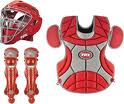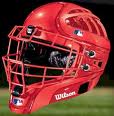Baseball Catcher Glossary:
The benefit of knowing a Baseball Catcher Glossary is the ability to quickly understand what a coach or other player is talking about. Armed with this information you are better equipped to play the game, understand the game and communicate with other players during the game.
Arm Band Exercises - This baseball aid is designed to strengthen the rotator cuff and shoulder muscles, as well as a warm up devise before a game or practice.
Arm Position - implies the correct positioning and follow through of the arm in the ready, throwing or relaxed position.
Blocking - pertains to the correct body movements a catcher makes in order to block a wild pitch or a pitch in the dirt.
Baseball Catcher Glossary

Baseball Catcher Glossary - Classic Brush Back
Breaking Ball - A pitch a catcher calls for which changes directions sideways or downwards while in flight due to a designed spin.
Brush Back Pitch - is a pitch a catcher calls for to be located inside forcing the batter back off the plate. This pitch is also used to set up an outside pitch.
Bullpen - A specified area where pitchers warm up before entering the game. This area is used by the starting pitcher and relief pitchers.
Busting the Hitter - is a term used to describe locating a pitch, fastball, inside and up on a hitter, which jams him.
Catcher’s Interference - This is a baseball rule which forbids the catcher from interfering with the batter’s swing. For instance, if the batter swings and hits the catcher’s mitt because the mitt was too close to the swing zone. The penalty depends on the situation.
Baseball Catcher Glossary

A. If the batter hits the catcher’s mitt, but also hit’s the ball for a double, the double stands.
B. If the batter hits the mitt and grounds out or misses the ball, the batter is awarded first base and any base runners already on, advance 1 base.
Chest Protector - One part of the catcher’s protective equipment, which is worn over the chest in order to protect it from injury from foul balls. The protector is flexible and made of various cushioning materials. Some have shoulder protectors to them attached as well.
Crossed Up - refers to a mis-communication between the pitcher and catcher as to what pitch had been called for resulting in the pitcher throwing a different pitch than the catcher expects.
Cup and Jock Strap - is a very important piece of the catcher’s equipment designed to protect the groin area from injury.
Dropped Third Strike - This situation refers to a third strike, either by swinging or called, hit’s the dirt or is dropped by the catcher. If first base is occupied with less than 2 outs, the batter is declared out. However, if there are 2 outs or first base is not occupied, the catcher must tag the runner or throw him out at first base.
Baseball Catcher Glossary
Clickbank Products
Foul Tip - occurs when the batter swings and barely makes contact with the ball.
Framing - A skill used by catchers to move borderline pitches into the strike zone without the umpire noticing, by twisting their wrist and mitt.
Grip - The method to hold the baseball when throwing it. A four seam grip is the proper throwing grip because the ball travels truer and sinks instead of tailing away or rising. Baseball Catcher Glossary
Jab Step - Refers to one of the three main throwing styles a catcher can utilize to throw down to second base.
Mask - Important piece of a catcher’s equipment used to protect his head and face. Although the mask and skull cap are separate parts which make up the mask, the combination hockey mask style is becoming the favorite type to use.
Mitt - refers to the special glove type used by catchers which are different from other fielders.
Out Pitch - refers to the Best pitch a pitcher throws, which makes it the hardest pitch to hit.

Overhand Position - this is the correct method to catch a low strike. When catching a pitch low in the zone keep your wrist pointed towards the ground instead of flipping your mitt around. Pitches caught with the wrist up are almost allows called a ball.
Pick Off - is an attempt by either the pitcher or catcher to throw out a runner who has strayed too far off a base.
Ready Stance - is the position, ( a raised squat ) a catcher takes with runners on base or two strikes on the hitter.
Relaxed Stance - Position catcher takes with no runners on and less than 2 strikes on the batter.
Rock and Throw - is a method of throwing base runners out attempting to steal.
Secondary Lead - is the lead the runner gets after the pitcher releases the pitch. It’s important the catcher monitor a runner’s secondary lead in order to possibly pick him off the base if it’s too large.
Shin Guards - another piece of catcher protective equipment which protects the knees, lower legs, ankles and feet from foul ball injuries. They’re made of plastic and are padded on the inside.
Baseball Catcher Glossary

Signs - The main method of communication between the pitcher and the catcher as to what the next pitch will be. The catcher also communicates with fielders through the use of signs.
Slide-Blocking - A term used in describing the physical movements a catcher makes attempting to block the plate from a sliding runner.
Square to the Pitcher - important body positioning which requires the catcher to keep his shoulders and hips parallel to the pitcher.
Stance - refers to the two catcher’s stances, ready and relaxed.
Sticking the Strike - refers to catching a definite strike and holding or hesitating with your mitt where the umpire can clearly see it. This is important as it plants the seed in the umpire’s mind that your pitcher is mainly throwing strikes, which may get you the benefit of the doubt on a close pitch.
Umpire’s Zone - is the strike zone the umpire is calling, which is usually different from other umpires and the rule book.
Underhand Position - is the Incorrect method to catch a low pitch, which will normally result in the pitch being called a ball.
Waste Pitch - is a pitch designed to be outside of the strike zone which will entice the batter to swing at a bad pitch or to set up the next pitch location and type.
Baseball Catcher Glossary to Playing Catcher

New! Comments
Have your say about what you just read! Leave me a comment in the box below.